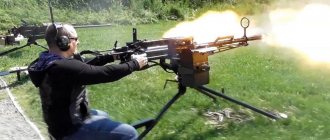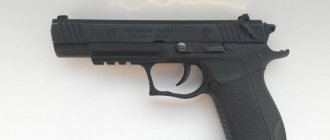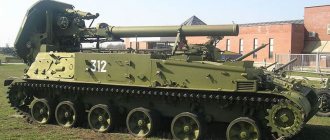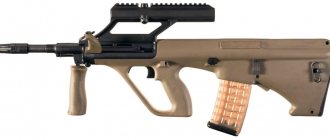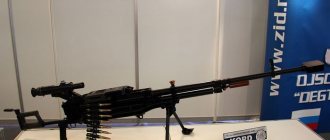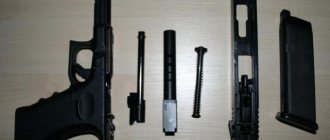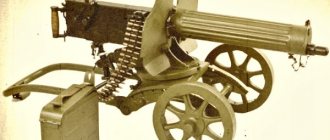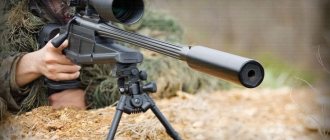The effectiveness of shooting depends on a number of characteristics. Among them, the rate of fire is of particular importance. This indicator determines how many shots a weapon can fire per unit of time.
The fastest-firing machine guns are multi-barreled. They give a slower rate of fire from one barrel. However, the overall speed is much higher than the average for single-barreled guns.
What is the rate of fire:
- Real. Combat rate of fire takes into account the need to reload weapons and aim.
- Technical. When calculating this parameter, only the total number of shots that the weapon can fire per minute matters.
- It is also worth distinguishing the rate of fire. This is the technical speed achieved when opening fire in automatic mode. Leads to overheating of the gun and increased waste of ammunition.
The maximum rate of fire is shown by multi-barrel guns made according to the Gatling scheme:
- technical - up to 10,000 rounds per minute;
- combat - up to approximately 2,000 rounds per minute.
In recent decades, it has been considered more promising to invest in the development of shooting range and accuracy. High-velocity machine guns have a very high ammo consumption, making them too expensive to use.
Top 10 best machine guns in the world.
A machine gun refers to a group or individual automatic small weapon, which, due to its design, can operate continuously mainly by using the energy of gases that escape from the barrel during a shot. Some machine gun models can use the energy generated by the recoil of the barrel. Typically, machine guns are equipped with a special tripod or other base, which keeps the automatic weapon stable during shooting.
People have been trying to invent a machine gun since ancient times. But the direct ancestor of modern machine guns is the mitrailleuse - a weapon with several barrels, equipped with a manual drive. As a rule, these old examples of the first machine guns were several rifles equipped with a special crankshaft mechanism, which was operated by a handle.
In 1962, Richard Jordan Gatling patented a multi-shot weapon - the Gatling gun. This machine gun was first used in the American Civil War. This weapon was equipped with a revolving barrel block and a manual drive. This design subsequently found its way into rapid-firing machine guns and cannons installed on combat aircraft and helicopters. This Gatling gun was also used in the Franco-Prussian wars of 1870 and 1871.
And what machine guns are among the most effective today, which is why many armies of the world fear them? Here are the top ten best machine guns in the world.
Ultrasound
Undoubtedly, the Uzi is a very famous specimen and therefore it tops the best submachine guns in the world today. Production started in Israel, where it turned out to be a complete necessity. This weapon is designed to hit targets in deserts and mountains. Balance was achieved thanks to the handle in the central part. You can shoot from it in both automatic and single mode. The Uzi submachine gun developed in 1948 and to this day is not much inferior to newer competitors. It is very good during close combat, which is why it is used by members of special forces and special forces. Other powerful submachine guns can hardly compete with it in popularity.
- Country: Israel
- Caliber: 9 mm
- Rate of fire: 600 high/min.
- Speed: 400 m/s
- Range: 200 m
- Weapon length: 650 mm
- Weight: 3.5 kg.
Minigun (Gatling M134)
Entered into service : 1960
Initial bullet speed: 869 meters per second
Sighting range: 500 meters
Firing rate: up to 6000 rounds per minute
The US Army Gatlin M134 machine gun model belongs to the M134 series of high-velocity machine guns. The weapon's design makes extensive use of a small 7.62mm barrel. The US Air Force model of the machine gun is called the GAU-2B/A, and the US Navy model is called the GAU-. Type 17/A. This rapid-fire machine gun has a maximum firing rate of up to 6,000 rounds per minute and is known as the world's fastest machine gun.
The machine gun was developed in the early 1960s by General Electric (now Lockheed Martin Ordnance Systems). The first machine gun had six barrels and was called the M61Al "Vulcan". Caliber - 5.56 mm (0.223 inches). Anything within a hundred meters can be penetrated by this weapon's ammunition. For the US Air Force, this weapon was redesigned and the 7.62 mm GAU-2 machine gun was developed, which was used on US Air Force light aircraft and helicopters. This weapon is incredibly powerful and was used extensively during the Vietnam War.
DSR sniper rifle
The DSR sniper rifle is the brainchild of DSR Precision, which was developed using advanced technology and engineering achievements. Reload time is kept to a minimum, making it one of the most dangerous of all weapons in its class.
Its length is 54 inches, weight is 22 pounds, barrel size is 660 mm, cartridge is 7.6 * 50 mm NATO. This rifle is relatively expensive, but the price is well justified by the quality. It is mainly used by professional snipers and shooters.
RPK (Kalashnikov light machine gun)
Entered into service: 1959
Initial bullet speed: 745 meters per second
Sighting range: 1000 meters
Firing rate: up to 600 rounds per minute
RPK is an abbreviation for Kalashnikov Light Machine Gun. This is a light machine gun developed on the basis of the Kalashnikov assault rifle (AKM). The Kalashnikov light machine gun was adopted by the Soviet Army in 1959. The RPK differs from the AKM in many design features: an extended barrel, increased muzzle velocity, increased magazine capacity (to increase sustained firepower). The machine gun is also equipped with a folding bipod to improve shooting accuracy, and a sight with wind deflection adjustment. The RPK worked on the same principle as the Degtyarev light machine gun.
M61 Vulkan
developed its product in 1949, as part of a competition to create an aircraft machine gun. The design of the Vulcan was simple, but it marked a new milestone in the development of the Gatling system.
The M61A1 is the standard machine gun in service with American aircraft. In its most promising modification, it began to be used in 1956. It is distinguished by its reliable design and fires up to 6,000 – 6,000 bullets per minute.
Each barrel has its own chamber and bolt. The movement of the latter is possible due to rollers moving along a groove in the stem box. The cartridges come from the magazine using a linkless system.
Electro-capsule ignition. The drive system is usually external, hydraulic. In some modern modifications, the block is spun by an electric motor.
American heavy machine gun Browning M2HB (Browning М2HB)
Entered into service: 1933
Initial bullet speed: 800-895 meters per second
Sighting range: 1830 meters
Rate of fire: up to 485-635 (M2HB) (military), 750-850 (M2) (aviation), 1200 (M3) (aviation) rounds per minute
The American Browning M2HB machine gun began to be developed at the end of the First World War and was finally released in 1932. In 1921, the first prototype was named Browning M1921. During test firing, it was discovered that the M2HB machine gun's barrel was too thin, causing it to overheat as the machine gun fired too quickly.
As a result, by 1932, Browning developed a different barrel for the machine gun, and also made many other design changes.
This is how the Browning machine gun appeared, which was called the Browning M2HB. Based on it, various modifications of the machine gun were developed over time, including tank automatic weapons, as well as weapons for aviation. see also
What happens if you shoot 700 bullets from a machine gun: Video
CZ Scorpion EVO 3
The top submachine gun pistols also includes a Czechoslovakian unit. From day one, development took place in Slovakia since 2002, and a couple of years later the first prototypes began to appear. Production began en masse in 2010. The CZ Scorpion EVO 3 operates according to the classic blowback design, and fires with the bolt closed. The magazine can hold up to 30 rounds at a time.
- Country: Slovakia and Czech Republic
- Caliber: 9 mm
- Rate of fire: 1150 rpm.
- Speed: 370 m/s
- Range: 250 m
- Weapon length: 660 mm
- Weight: 2.77 kg.
Czechoslovakian machine gun ZB26 7.92 mm
Entered into service: 1924
Initial bullet speed: 744 meters per second
Sighting range: 1000 meters
Firing rate: up to 500 rounds per minute
This weapon was developed in 1924 by the Czechoslovak arms company, which belonged to the Czech weapons designer Vaclav Holek. The machine gun was developed taking into account the design principles of the French Haqi Kais machine gun and the American Browning machine gun. Gunsmith Vaclav Holek used the advantages of these two types of weapons to create his machine gun, which makes the ZB26 machine gun one of the most famous in the world. The machine gun was designed for the German 7.92x57 mm cartridge. In 1926, the machine gun was adopted by the Czechoslovak army and was also sold to 24 countries around the world.
FN P90
The best submachine gun of our time, which was developed in 1990 for tank crews and combat vehicle drivers. A 5.7*28 mm SS190 caliber cartridge was developed specifically for this type of weapon. They have powerful penetrating power and no ricochets. Its power is so serious that it can penetrate titanium body armor at a distance of up to 20 meters. The FN P90 can often be seen in some science fiction films. This opportunity was given to him by a unique design, different from the usual one. By the way, such powerful submachine guns are capable of piercing a helmet at a distance of 150 meters.
- Country: Belgium
- Caliber: 5.7 mm
- Rate of fire: 1000 high/min.
- Speed: 715 m/s
- Range: 200 m
- Weapon length: 500 mm
- Weight: 3.1 kg.
Degtyarev light machine gun (DP)
Entered into service: 1928
Initial bullet speed: 840 meters per second
Sighting range: 1500 meters
Firing rate: up to 500-600 rounds per minute
The Degtyarev DP and DPM light machine guns of 7.62 caliber were developed in our country during the Soviet Union by the Russian Soviet designer Vasily Alekseevich Degtyarev.
The machine gun began to be developed in 1923, and already in 1924 it underwent successful shooting tests, where the weapon was highly praised by a special commission. In 1927, the first pre-production batch of machine guns was manufactured, which were transferred for military testing. At the end of the same year, based on the results of successful tests, a decision was made to accept the weapon for service.
This machine gun played an important role during the Great Patriotic War. Due to its characteristics and simplicity of design, the machine gun could operate in any field conditions. But, like any machine gun of those years, there were problems. Thus, it was discovered that after continuous firing, the barrel became very hot; this caused heating of the input spring located under the barrel, which affected the normal operation of the weapon. As a result, it was decided to make changes to the design of the machine gun. The spring was moved to the tail of the machine gun. The new weapon was called the DPM (modernized Degtyarev light machine gun 1944).
see also
How good was the military equipment of the USSR during the Great Patriotic War?
GSh-6-23
The Gryazev-Shipunov GSh-6-23 design used the Gatling system. This is a 6-barrel aircraft machine gun that fires 9,000 bullets per minute. Rotating barrels with bolts are combined into one block. It rotates in a fixed casing, along with the central star.
The shutters slide along the star, simultaneously making reciprocating movements. For each revolution they are recharged. The barrels at the same time fire a series of successive shots.
Acceleration is provided by a cassette pyrostarter with 10 squibs. The automation operates on the gun’s own powder gases. They enter the engine from the barrels through special holes.
Due to the high feed speed of the cartridges, the belt jerks and the links burst. Strong recoil loosens the mounts, knocks down the sight and has a bad effect on aircraft equipment. It is more effective to fire in short bursts. Reliability life – 18,000 shots.
HK21 general purpose machine gun
Years of production: 1961 – early 2000s
Initial bullet speed: 800 meters per second
Sighting range: up to 1200 meters
Firing rate: up to 800 rounds per minute
The NK21 series of German machine guns was developed by Heckler & Koch. This weapon model was based on the German NK G3 automatic rifle. As a result, 48% of the HK21 machine gun parts can be interchanged with the G3 rifle parts. The HK21 general purpose machine gun is the earliest model of this series of weapons. This machine gun can be used for both single shots and continuous shooting. The design feature of the machine gun is that when the shooting stops, overheating of the barrel and other parts of the weapon does not allow other bullets to spontaneously ignite.
M 214 Microgun
The lightweight version of the XM 134 was designed to create high-density fire in infantry formations. With its help it was planned to arm small helicopters and cars. When mounted on a machine, it fired 4,000 bullets per minute. Potentially developed a rate of fire of up to 6,000.
However, this weapon did not become widespread. Practical application was complicated by numerous shortcomings of this development. The project remained realized only in the movies; according to the story, Arnold Schwarzenegger appears in the film “Terminator” with this weapon.
The high rate of fire made it difficult for the electrical unit to control the fire. The weight of the gun still remained significant, especially when assembled - with a machine tool, cartridges and battery. Strong recoil at a fast rate of fire reached up to 110 kg. This destroyed the fastenings, which complicated the process of managing the installation. In addition, the creators were never able to achieve good effective firing range indicators.
American M249 SAW machine gun
Entered into service: 1984
Initial bullet speed: 925-975 meters per second
Sighting range: 600 m (bipod-single targets), 800 m (tripod-single targets), 800 m (bipod-group targets), 1000 m (tripod-group targets)
Firing rate: up to 700-1150 rounds per minute
The M249 machine gun, also known as the XM249, is an automatic weapon based on the FNMinimi light machine gun. The M249 SAW is a variant of the upgraded FNMinimi machine gun and has a caliber of 5.56 x 45 mm. The M249 machine gun is manufactured by FN Manufacturing, an American subsidiary of the Belgian company FN Herstal.
The machine gun began to be developed in 1966, but entered service only in 1984. Currently, production of the machine gun continues.
PP-91
Many are familiar with this weapon as the “Kedr”, a very interesting version of the design of Evgeniy Dragunov and undoubtedly worthy of entry into the best submachine guns of 2021 . The unit was developed on the basis of the PP-71 and the first copies were released in 1992. He began joining the army and police in 1994. It is extremely simple in design, but the factory managed to increase power, reliability and endurance in difficult situations. The overall weight and dimensions have also been reduced. Currently used exclusively in Russia.
- Country: Russia
- Caliber: 9 mm
- Rate of fire: 1000 high/min.
- Speed: 310 m/s
- Range: 100 m
- Weapon length: 530 mm
- Weight: 1.66 kg.
(Visited 859 times, 3 visits today)
MG-42 machine gun
Entered into service: 1942
Initial bullet speed: 750-1000 meters per second
Sighting range: 400-1000 meters
Firing rate: up to 800-1500 (depending on the shutter used) rounds per minute
The MG-42 is a German general purpose machine gun that was used by Germany during World War II and on Russian soil during World War II. The weapon was developed by Metall-und Lackwarenfabrik Johannes Großfuß in 1942. MG-42 is an abbreviation for the German word Maschinengewehr 42, which means “automatic pistol” (“Maschinen” - “automatic”; “gewehr” - “pistol”). The machine gun was supposed to replace the MG-34 machine gun.
But, despite this, both machine guns were used and produced until the end of the war. The MG-42 machine gun had a caliber of 7.92 mm. Its main feature is its high rate of fire. For this, the machine gun received many different nicknames: “Bone Cutter”, “Hitler’s Saw”, “Emga”, “Krestovik”.
At the end of the war, Germany produced about 423.6 thousand MG-42 machine guns. In the 1950s, Germany improved the machine gun chambered for the NATO 7.62 × 51 mm caliber cartridge, renaming it MG1.
Another important modification of the MG42 machine gun is the MG3.
see also
New military trucks
FAMAE SAF
A copy that was released in 1993 from the Chilean manufacturer of the popular brand. Today he is among the best submachine guns 2021 and is not going to leave them. The weapon fires from a closed bolt; the design was mainly taken from the Swiss SIG assault rifle. The magazine holds up to 30 rounds of 9-gauge ammunition. Popular in Costa Rica, El Salvador and Chile itself.
- Country: Chile
- Caliber: 9 mm
- Rate of fire: 1200 high/min.
- Speed: 350 m/s
- Range: 150 m
- Weapon length: 640 mm
- Weight: 2.7 kg.
US Browning M1918A2 machine gun (Browning M1918)
Entered into service: 1918
Initial bullet speed: 860 meters per second
Sighting range: 91.44-1371.6 meters
Firing rate: up to 500-650 rounds per minute
The Browning M1918 is an automatic rifle or light machine gun that is designed by John Moses Browning. This weapon has an air-cooled barrel, gas-operated automatics and a cartridge magazine. The first version used .30-06 Springfield (7.62x63mm) cartridges. This weapon was created in 1917 by John Browning.
The M1918 machine gun was developed for infantrymen. For example, with this weapon it is easier to go on the attack. The fact is that the machine gun could be carried on a belt. But the main thing is that it could be fired from the hip. But in practice, the Americans used this machine gun mainly from the ground - from a stationary position (the machine gun was mounted on a bipod - a special tripod). This weapon showed itself most clearly in World War II and, of course, during the Vietnam War. At the end of the 1950s, the machine gun gradually began to be removed from service, replacing it with the new M60 machine gun, and then the M249.
